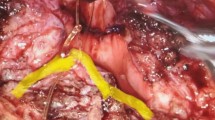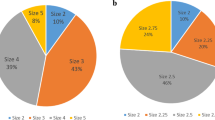Abstract
Introduction and hypothesis
The primary aim of this study was to assess for an association between maximal intra-abdominal pressure reached on Valsalva (MAP) and pelvic organ prolapse (POP) on subjective, clinical and sonographic evaluation. Another objective was to test for association between MAP and body mass index (BMI).
Methods
A retrospective cross-sectional study was carried out on 504 archived datasets of women seen for pelvic floor dysfunction symptoms between January 2017 to September 2019 at a tertiary urogynaecology clinic. Patients underwent a standardized interview including use of visual analogue scores (VAS) to evaluate bother of pelvic floor symptoms, examination using the International Continence Society Pelvic Organ Prolapse Quantification (ICS POP-Q), dual-channel filling and voiding cystometry, test for MAP as well as four-dimensional (4D) transperineal ultrasound. Analysis of ultrasound volumes for pelvic organ descent was performed blinded against all other data.
Results
There was a weak but significant association between MAP and sonographic rectal ampulla descent (p = 0.0275). There was also a significant association between MAP and bother of obstructed defecation symptoms (p = 0.0065). Symptomatic, clinical and sonographic POP in the anterior or the apical compartments was not significantly associated with MAP. On multivariate analysis, the association between MAP and rectal descent remained significant (p = 0.01). There was no significant association between BMI and MAP.
Conclusions
This cross-sectional study showed an association between MAP and posterior compartment prolapse on imaging as well as between MAP and the bother score of obstructed defecation symptoms. There was no association between BMI and MAP.

Similar content being viewed by others
References
Hendrix SL, et al. Pelvic organ prolapse in the Women's Health Initiative: gravity and gravidity. Am J Obstet Gynecol. 2002;186(6):1160.
Olsen AL, et al. Epidemiology of surgically managed pelvic organ prolapse and urinary incontinence. Obstet Gynecol. 1997;89(4):501.
Smith FJ, Holman CDJ, Moorin RE, Tsokos N. Lifetime risk of undergoing surgery for pelvic organ prolapse. Obstet Gynecol. 2010;116(5):1096–100.
Dietz HP. The aetiology of prolapse. Int Urogynecol J. 2008;19(10):1323–9.
Vergeldt TF, Weemhoff M, IntHout J, Kluivers KB. Risk factors for pelvic organ prolapse and its recurrence: a systematic review. Int Urogynecol J. 2015;26(11):1559–73.
Young N, Atan IK, Guzman Rojas R, Dietz HP. Obesity: how much does it matter for female pelvic organ prolapse? Int Urogynecol J. 2018;29(8):1129–34.
Swift S, Woodman P, O'Boyle A, Kahn M, Valley M, Bland D, et al. Pelvic organ support study (POSST): the distribution, clinical definition, and epidemiologic condition of pelvic organ support defects. Am J Obstet Gynecol. 2005;192(3):795–806.
Swift S, Woodman P, O’Boyle A, et al. Pelvic organ support study (POSST): the distribution, clinical definition and epidemiologic condition of pelvic organ support defects. Am J Obstet Gynecol. 2005;192:795–806.
Noblett KL, Jensen JK, Ostergard DR. The relationship of body mass index to intra-abdominal pressure as measured by multichannel Cystometry. Int Urogynecol J. 1997;8:323–6.
Ulrich D, Guzman Rojas R, Dietz HP, Mann K, Trutnovsky G. Use of a visual analog scale for evaluation of bother from pelvic organ prolapse. Ultrasound Obstet Gynecol. 2014;43:693–7.
Haylen BT, de Ridder D, Freeman RM, et al. An international Urogynaecological association (IUGA)/international continence society (ICS) joint report on the terminology for female pelvic floor dysfunction. Neurourol Urodynamics. 2010;29:4–20.
Schafer W, Abrams P, Liao L, et al. Good urodynamic practices: Uroflowmetry, filling Cystometry, and pressure-flow studies. Neurourol Urodynamics. 2002;21:261–74.
Dietz HP. Ultrasound imaging of the pelvic floor. II: three- dimensional or volume imaging. Ultrasound Obstet Gynecol. 2004;23(6):615–25.
Dietz HP, Mann KP. What is clinically relevant prolapse? An attempt at defining cutoffs for the clinical assessment of pelvic organ descent. Int Urogynecol J. 2014;25(4):451–5.
Bump RC, Mattiasson A, Bø K, Brubaker LP, JOL DL, Klarskov P, et al. The standardization of terminology of female pelvic organ prolapse and pelvic floor dysfunction. Am J Obstet Gynecol. 1996;175(1):10–7.
Dietz H, Haylen B, Broome J. Ultrasound in the quantification of female pelvic organ prolapse. Ultrasound Obstet Gynecol. 2001;18(5):511–4.
Shek KL, Dietz HP. What is abnormal uterine descent on translabial ultrasound? Int Urogynecol J. 2015;26(12):1783–7.
Shek KL, Dietz HP. Assessment of pelvic organ prolapse: a review. Ultrasound Obstet Gynecol. 2016;48:681–92.
Dietz HP, Steensma AB. Posterior compartment prolapse on two- dimensional and three-dimensional pelvic floor ultrasound: the distinction between true rectocele, perineal hypermobility and enterocele. Ultrasound Obstet Gynecol. 2005;26(1):73–7.
Guzman Rojas R, Kamisan Atan I, Shek KL, et al. The prevalence of abnormal posterior compartment anatomy and its association with obstructed defecation symptoms in urogynaecological patients. Int Urogynecol J. 2016;27:939–44.
Braverman M, Kamisan Atan I, Turel F, et al. Does patient posture affect the ultrasound evaluation of pelvic organ prolapse? J Ultrasound Med. 2019;38:233–8.
Rodriguez-Mias NL, Subramaniam N, Friedman T, et al. Prolapse assessment supine and standing: do we need different cutoffs for “significant prolapse”? Int Urogynecol J. 2018;29:685–9.
Author information
Authors and Affiliations
Contributions
YH Tan: Protocol/project development; Data collection, management and analysis; Manuscript writing.
M Gillor: Data analysis; Manuscript editing.
HP Dietz: Protocol/project development; Manuscript editing.
Corresponding author
Ethics declarations
Conflict of interest
HP Dietz received lecture honoraria and travel assistance from GE Medical and Mindray. YH Tan and M Gillor declare they have no conflict of interest.
Additional information
Publisher’s note
Springer Nature remains neutral with regard to jurisdictional claims in published maps and institutional affiliations.
Oral abstract presentation at Urogynaecological Society of Australasia ASM 2020 (Virtual), 20– 21 November 2020
E-Poster presentation at IUGA 45th Annual Scientific Meeting 2020 (Virtual); 29 August–4 September 2020.
Rights and permissions
About this article
Cite this article
Tan, Y.H., Gillor, M. & Dietz, H.P. Abdominal pressure and pelvic organ prolapse: is there an association?. Int Urogynecol J 33, 337–342 (2022). https://doi.org/10.1007/s00192-021-04811-0
Received:
Accepted:
Published:
Issue Date:
DOI: https://doi.org/10.1007/s00192-021-04811-0




